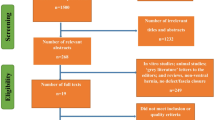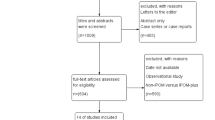Abstract
Purpose
Laparoscopic and robotic inguinal hernia mesh repair are both common surgical procedures worldwide. Postoperative hernia recurrence and seroma formation are important concerns. In ventral hernia, primary defect closure in laparoscopic surgery reduces the recurrence rate. However, there is no synthetic evidence of direct inguinal hernia defect closure versus non-closure in minimal invasive surgery. Therefore, this study investigated the efficacy of defect closure in patients undergoing minimal invasive direct inguinal hernia mesh repair.
Methods
Eligible studies were identified through a search of PubMed, Embase, Cochrane Library, and CINAHL from their inception until March 2022. Studies examining defect closure in laparoscopic direct inguinal hernia repair were included, and a meta-analysis was performed using the random-effect model. Sensitivity analyses were performed by removing one study at a time. The primary outcomes were hernia recurrence and seroma formation. Acute and chronic postoperative pain, operation time, and length of hospital stay were the secondary outcomes.
Results
Five nonrandomized studies and one randomized controlled trial were included. Pooled analysis revealed defect closure might reduce the hernia recurrence rate (risk difference, − 0.02; 95% confidence interval [CI] − 0.04 to − 0.00; p = 0.02). The result of seroma formation (odds ratio, 0.49; 95% CI 0.17–1.46; p = 0.20) showed no significant difference. Moreover, no significant differences were observed in acute postoperative pain, chronic pain, length of hospital stay, and operation time.
Conclusions
Our study indicated defect closure seems to be an option to reduce the direct inguinal hernia recurrence rate. No significant benefits were shown in seroma formation and other secondary outcomes. Our study was mostly based on nonrandomized studies and underestimated the effect of defect closure; thus, further high-quality studies are required to draw definitive conclusions.




Similar content being viewed by others
Data availability
The datasets generated during and analysed during the current study are available from the corresponding author on reasonable request.
References
Aiolfi A, Cavalli M, Micheletto G, Lombardo F, Bonitta G, Morlacchi A, Bruni PG, Campanelli G, Bona D (2019) Primary inguinal hernia: systematic review and Bayesian network meta-analysis comparing open, laparoscopic transabdominal preperitoneal, totally extraperitoneal, and robotic preperitoneal repair. Hernia 23(3):473–484
Aiolfi A, Cavalli M, Ferraro SD, Manfredini L, Bonitta G, Bruni PG, Bona D, Campanelli G (2021) Treatment of inguinal hernia: systematic review and updated network meta-analysis of randomized controlled trials. Ann Surg 274(6):954–961
K. McCormack, N. W. Scott, P. M. Go, S. Ross, A. M. Grant and E. U. H. T. Collaboration (2003) Laparoscopic techniques versus open techniques for inguinal hernia repair. Cochrane Database Syst Rev. 2003;2003(1):CD001785
Bullen NL, Massey LH, Antoniou SA, Smart NJ, Fortelny RH (2019) Open versus laparoscopic mesh repair of primary unilateral uncomplicated inguinal hernia: a systematic review with meta-analysis and trial sequential analysis. Hernia 23(3):461–472
Schmedt CG, Sauerland S, Bittner R (2005) Comparison of endoscopic procedures vs Lichtenstein and other open mesh techniques for inguinal hernia repair: a meta-analysis of randomized controlled trials. Surg Endosc 19(2):188–199
Kockerling F, Bittner R, Adolf D, Fortelny R, Niebuhr H, Mayer F, Schug-Pass C (2018) Seroma following transabdominal preperitoneal patch plasty (TAPP): incidence, risk factors, and preventive measures. Surg Endosc 32(5):2222–2231
Bracale U, Melillo P, Pignata G, Di Salvo E, Rovani M, Merola G, Pecchia L (2012) Which is the best laparoscopic approach for inguinal hernia repair: TEP or TAPP? A systematic review of the literature with a network meta-analysis. Surg Endosc 26(12):3355–3366
McCormack K, Wake BL, Fraser C, Vale L, Perez J, Grant A (2005) Transabdominal pre-peritoneal (TAPP) versus totally extraperitoneal (TEP) laparoscopic techniques for inguinal hernia repair: a systematic review. Hernia 9(2):109–114
Tandon A, Pathak S, Lyons NJ, Nunes QM, Daniels IR, Smart NJ (2016) Meta-analysis of closure of the fascial defect during laparoscopic incisional and ventral hernia repair. Br J Surg 103(12):1598–1607
Nguyen DH, Nguyen MT, Askenasy EP, Kao LS, Liang MK (2014) Primary fascial closure with laparoscopic ventral hernia repair: systematic review. World J Surg 38(12):3097–3104
Li J, Gong W, Liu Q (2019) Intraoperative adjunctive techniques to reduce seroma formation in laparoscopic inguinal hernioplasty: a systematic review. Hernia 23(4):723–731
Li J, Zhang W (2018) Closure of a direct inguinal hernia defect in laparoscopic repair with barbed suture: a simple method to prevent seroma formation? Surg Endosc 32(2):1082–1086
Reddy VM, Sutton CD, Bloxham L, Garcea G, Ubhi SS, Robertson GS (2007) Laparoscopic repair of direct inguinal hernia: a new technique that reduces the development of postoperative seroma. Hernia 11(5):393–396
Sterne JAC, Savovic J, Page MJ, Elbers RG, Blencowe NS, Boutron I, Cates CJ, Cheng HY, Corbett MS, Eldridge SM, Emberson JR, Hernan MA, Hopewell S, Hrobjartsson A, Junqueira DR, Juni P, Kirkham JJ, Lasserson T, Li T, McAleenan A, Reeves BC, Shepperd S, Shrier I, Stewart LA, Tilling K, White IR, Whiting PF, Higgins JPT (2019) RoB 2: a revised tool for assessing risk of bias in randomised trials. BMJ 366:l4898
Sterne JA, Hernan MA, Reeves BC, Savovic J, Berkman ND, Viswanathan M, Henry D, Altman DG, Ansari MT, Boutron I, Carpenter JR, Chan AW, Churchill R, Deeks JJ, Hrobjartsson A, Kirkham J, Juni P, Loke YK, Pigott TD, Ramsay CR, Regidor D, Rothstein HR, Sandhu L, Santaguida PL, Schunemann HJ, Shea B, Shrier I, Tugwell P, Turner L, Valentine JC, Waddington H, Waters E, Wells GA, Whiting PF, Higgins JP (2016) ROBINS-I: a tool for assessing risk of bias in non-randomised studies of interventions. BMJ 355:i4919
DerSimonian R, Laird N (1986) Meta-analysis in clinical trials. Control Clin Trials 7(3):177–188
Borenstein M, Hedges LV, Higgins JP, Rothstein HR (2010) A basic introduction to fixed-effect and random-effects models for meta-analysis. Res Synth Methods 1(2):97–111
Rice K, Higgins JPT, Lumley T (2018) A re-evaluation of fixed effect(s) meta-analysis. J R Stat Soc A Stat Soc 181(1):205–227
Julian PT Higgins SG (2011) Cochrane handbook for systematic reviews of interventions. Studies with no events. https://handbook-5-1.cochrane.org/chapter_16/16_9_3_studies_with_no_events.htm. Accessed 31 May 2022
Cheng J, Pullenayegum E, Marshall JK, Iorio A, Thabane L (2016) Impact of including or excluding both-armed zero-event studies on using standard meta-analysis methods for rare event outcome: a simulation study. BMJ Open 6(8):e010983
Julian PT Higgins SG (2011) Cochrane handbook for systematic reviews of interventions. Identifying and measuring heterogeneity. https://handbook-5-1.cochrane.org/chapter_9/9_5_2_identifying_and_measuring_heterogeneity.htm. Accessed 31 May 2022
Zhu Y, Liu M, Li J, Wang M (2019) Closure of direct inguinal hernia defect in laparoscopic hernioplasty to prevent seroma formation: a prospective double-blind randomized controlled trial. Surg Laparosc, Endosc Percutaneous Tech 29(1):18–21
Lee SR, Park S-S (2018) The novel technique of transabdominal preperitoneal hernioplasty herniorrhaphy for direct inguinal hernia: suture repair of hernia defect wall. J Laparoendosc Adv Surg Tech 28(1):83–88
Ng AY, Lin J, Ching SS, Lee J, Wong ASY (2020) Does primary closure of direct inguinal hernia defect during laparoscopic mesh repair reduce the risk of early recurrence? Hernia 24(5):1093–1098
Usmani F, Wijerathne S, Malik S, Yeo C, Rao J, Lomanto D (2020) Effect of direct defect closure during laparoscopic inguinal hernia repair (“TEP/TAPP plus” technique) on post-operative outcomes. Hernia 24(1):167–171
Kudsi OY, Bou-Ayash N, Gokcal F, Chang K (2021) Robotic direct inguinal hernia repair: to plicate or not to plicate? Surg Laparosc Endosc Percutan Tech 31(6):716–721
Siddaiah-Subramanya M, Ashrafi D, Memon B, Memon MA (2018) Causes of recurrence in laparoscopic inguinal hernia repair. Hernia 22(6):975–986
Kukleta JF (2006) Causes of recurrence in laparoscopic inguinal hernia repair. J Minim Access Surg 2(3):187–191
Andresen K, Rosenberg J (2018) Management of chronic pain after hernia repair. J Pain Res 11:675–681
Habib Bedwani NAR, Kelada M, Smart N, Szydlo R, Patten DK, Bhargava A (2021) Glue versus mechanical mesh fixation in laparoscopic inguinal hernia repair: meta-analysis and trial sequential analysis of randomized clinical trials. Br J Surg 108(1):14–23
Reinpold W, Schroeder AD, Schroeder M, Berger C, Rohr M, Wehrenberg U (2015) Retroperitoneal anatomy of the iliohypogastric, ilioinguinal, genitofemoral, and lateral femoral cutaneous nerve: consequences for prevention and treatment of chronic inguinodynia. Hernia 19(4):539–548
Page MJ, McKenzie JE, Bossuyt PM, Boutron I, Hoffmann TC, Mulrow CD, Shamseer L, Tetzlaff JM, Akl EA, Brennan SE, Chou R, Glanville J, Grimshaw JM, Hrobjartsson A, Lalu MM, Li T, Loder EW, Mayo-Wilson E, McDonald S, McGuinness LA, Stewart LA, Thomas J, Tricco AC, Welch VA, Whiting P, Moher D (2021) The PRISMA 2020 statement: an updated guideline for reporting systematic reviews. BMJ 372:n71
Aiolfi A, Cavalli M, Del Ferraro S, Manfredini L, Lombardo F, Bonitta G, Bruni PG, Panizzo V, Campanelli G, Bona D (2021) Total extraperitoneal (TEP) versus laparoscopic transabdominal preperitoneal (TAPP) hernioplasty: systematic review and trial sequential analysis of randomized controlled trials. Hernia 25(5):1147–1157
Acknowledgements
The authors are grateful for grants supported from the Taipei Medical University Hospital (111TMUH-MOST-06) and Taipei Medical University–Taipei Municipal Wanfang Hospital (110TMU-WFH-07).
Funding
This research did not receive any specific grant from funding agencies from the public, commercial, or nonprofit sectors.
Author information
Authors and Affiliations
Contributions
TET, GHB and JCW designed the research; TET, GHB and WHH conducted the research; TET and GHB analyzed the data; TET, GHB and CHS wrote the manuscript; JCW and WHH reviewed the final manuscript.
Corresponding author
Ethics declarations
Conflict of interest
TET, GHB, CHS, JCW, and WHH have no conflicts of interest or financial ties to disclose.
Ethical approval
Approval of the research protocol by an Institutional Reviewer Board: PROSPERO (CRD42022306600). https://www.crd.york.ac.uk/prospero/display_record.php?RecordID=306600
Human and animal studies
Not applicable.
Informed consent
Not applicable.
Additional information
Publisher's Note
Springer Nature remains neutral with regard to jurisdictional claims in published maps and institutional affiliations.
Supplementary Information
Below is the link to the electronic supplementary material.


Rights and permissions
Springer Nature or its licensor (e.g. a society or other partner) holds exclusive rights to this article under a publishing agreement with the author(s) or other rightsholder(s); author self-archiving of the accepted manuscript version of this article is solely governed by the terms of such publishing agreement and applicable law.
About this article
Cite this article
Tai, TE., Bai, GH., Shiau, CH. et al. Fascia defect closure versus non-closure in minimal invasive direct inguinal hernia mesh repair: a systematic review and meta-analysis of real-world evidence. Hernia 27, 459–469 (2023). https://doi.org/10.1007/s10029-022-02732-5
Received:
Accepted:
Published:
Issue Date:
DOI: https://doi.org/10.1007/s10029-022-02732-5




